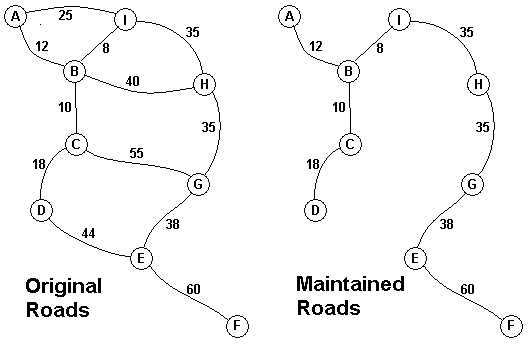NUC: http://acm.nuc.edu.cn/OJ/problem.php?pid=1396
Description:

The Head Elder of the tropical island of Lagrishan has a problem. A
burst of foreign aid money was spent on extra roads between villages
some years ago. But the jungle overtakes roads relentlessly, so the
large road network is too expensive to maintain. The Council of Elders
must choose to stop maintaining some roads. The map above on the left
shows all the roads in use now and the cost in aacms per month to
maintain them. Of course there needs to be some way to get between all
the villages on maintained roads, even if the route is not as short as
before. The Chief Elder would like to tell the Council of Elders what
would be the smallest amount they could spend in aacms per month to
maintain roads that would connect all the villages. The villages are
labeled A through I in the maps above. The map on the right shows the
roads that could be maintained most cheaply, for 216 aacms per month.
Your task is to write a program that will solve such problems.
Input:
The input consists of one to 100 data sets, followed by a final line containing only
0. Each data set starts with a line containing only a number n
,
which is the number of villages, 1 < n
< 27, and the villages
are labeled with the first n
letters of the alphabet, capitalized.
Each data set is completed with n
-1 lines that start with village
labels in alphabetical order. There is no line for the last village.
Each line for a village starts with the village label followed by a number,
k
,
of roads from this village to villages with labels later
in the
alphabet. If k
is greater than 0, the line continues with
data for each of the k
roads. The data for each road is the
village label for the other end of the road followed by the monthly maintenance
cost in aacms for the road. Maintenance costs will be positive integers
less than 100. All data fields in the row are separated by single
blanks. The road network will always allow travel between all the
villages. The network will never have more than 75 roads. No
village will have more than 15 roads going to other villages (before or
after in the alphabet). In the sample input below, the
first data set goes with the map above.
Output:
The output is one integer per line for each data set: the minimum cost in aacms
per month to maintain a road system that connect all the villages. Caution
:
A brute force solution that examines every possible set of roads will not
finish within the one minute time limit.
Example Input:
9
A 2 B 12 I 25
B 3 C 10 H 40 I 8
C 2 D 18 G 55
D 1 E 44
E 2 F 60 G 38
F 0
G 1 H 35
H 1 I 35
3
A 2 B 10 C 40
B 1 C 20
0
Example Output:
216
30
题解:该题使用的算法是Kruskal最小生成树
#include <stdio.h>
#include <stdlib.h>
#include <string.h>
#define E 27*27
#define N 27
typedef struct
{
int v1;
int v2; //节点v1,v2是两个节点的序号
int cost; //边的权值
} EdgeType;
EdgeType edges[E], T[N-1];
int Find(int father[], int v)
{
/*
*寻找顶点v所在树的根节点
*/
int t = v;
while(father[t] >= 0)
{
t = father[t];
}
return t;
}
void Kruskal(EdgeType edges[], EdgeType T[])
{
/*
*用Kruskal方法构造图的最小生成树
*edges是图中的各条边,而且已经按其权值从小到大排序,
*最小生成树的边在T中
*/
int i, j;
int father[N];
int vf1, vf2;
memset(father, -1, sizeof(father));
i = j = 0;
while(i < E && j < N-1)
{
vf1 = Find(father, edges[i].v1);
vf2 = Find(father, edges[i].v2);
if(vf1 != vf2)
{
/*vf1, vf2不在同一个集合中,联通两个集合*/
father[vf2] = vf1;
T[j] = edges[i];
j++;
}
i++;
}
}
int comp(const void *a, const void *b)
{
EdgeType p = *(EdgeType *)a;
EdgeType q = *(EdgeType *)b;
if((p.cost) >= (q.cost)) return 1;
else return -1;
}
int main()
{
int i, j, k;
int n, m;
int cost, total_cost;
char ch1, ch2;
while(scanf("%d", &n) && n)
{
getchar();
k = 0;
total_cost = 0;
/*
*输入节点以及边的权值
*/
for(i = 0; i < n-1; i++)
{
scanf("%c %d", &ch1, &m);
getchar();
for(j = 0; j < m; j++)
{
scanf("%c %d", &ch2, &cost);
getchar();
edges[k].v1 = ch1-'A'+1;
edges[k].v2 = ch2-'A'+1;
edges[k].cost = cost;
k++;
}
}
/*
*对节点按权值大小进行排序
*/
qsort(edges, k, sizeof(EdgeType), comp);
Kruskal(edges, T); //生成最小树
for(i = 0; i < n-1; i++)
{
/*计算总的最小权值*/
total_cost += T[i].cost;
}
printf("%d\n", total_cost);
}
return 0;
}
分享到:





相关推荐
数据结构中图的算法 Red and Black ,Knight Moves,Sorting It All Out,Jungle Roads,Stockbroker Grapevine
笔者本人写的一些代码,供大家参考. 包括但不限于镜子迷宫、棋盘问题、最长上升子序列、jungle roads gone fishing、nested dolls、paid roads、red and black等等 绝大部分是数据结构与算法课的作业
ZJU_Main 主页 下一页 ZJU 题型分类 文演整理版 2008-3-23 数论: 1007 Numerical Summation of a Series 简单题,还是蛮有意思的 1045 HangOver 简单题 ... 1049 I Think I Need a Houseboat 简单题 ...
ZJU 题型分类 ZJU_Main 主页 下一页 ZJU 题型分类 文演整理版 2008-3-23 数论: 1007 Numerical Summation of a Series 简单题,还是蛮有意思的 ... 1049 I Think I Need a Houseboat 简单题 ...
AudioJungle纯净人声,用于去Audiojungle水印,
本srm模型为高解析版的Audiojungle声音水印特别处理过的声音模型,理论上支持各种版本的AU去消除Audiojungle的声音水印,操作方式自行查找
懂的都懂,可以通过adobe 的audition 去掉 audio jungle 的水印 选择一段来自audiojungle.net的音频塑材,打开au,效果,降噪/恢复 声音移除,然后再也听不到那个女人的声音了
Jungle卡通
这个文件是Audio Jungle音频素材中的纯净人声,自行百度去水印方法,去除水印必须有纯净的人声,这是去水印必备的
在envato下载了非常不错的片头特效,结果发现里面的背景音乐居然要从另外一个站点下载,且下下来发现每个音乐都带了超多audiojungle的水印背景音,于是乎,需要用到它。
AudioJungle水印去除文件,用于识别人声,后期音频水印处理。详情可见:https://dengxj.blog.csdn.net/article/details/103193336
Jungle
去除Audio Jungle水印,这个文件是Audio Jungle音频素材中的纯净人声,自行百度去水印方法,去除水印必须有纯净的人声,这是去水印必备的
Jungle Defence is a game where you have to withstand waves of enemy attack to protect you base in the jungle.
资源来自pypi官网。 资源全名:jungle-0.2.0.tar.gz
压缩包内包含audio jungle水印原版音频、Audition降噪移除声音所需要的SRM模型文件
Unity Asset - 卡通原始森林(Stylized Jungle Pack.unitypackage)
jungle scout pro 跨境电商亚马逊必备工具 抓取产品大数据
2021年亚马逊卖家报告-Jungle Scout-2021-34页.pdf